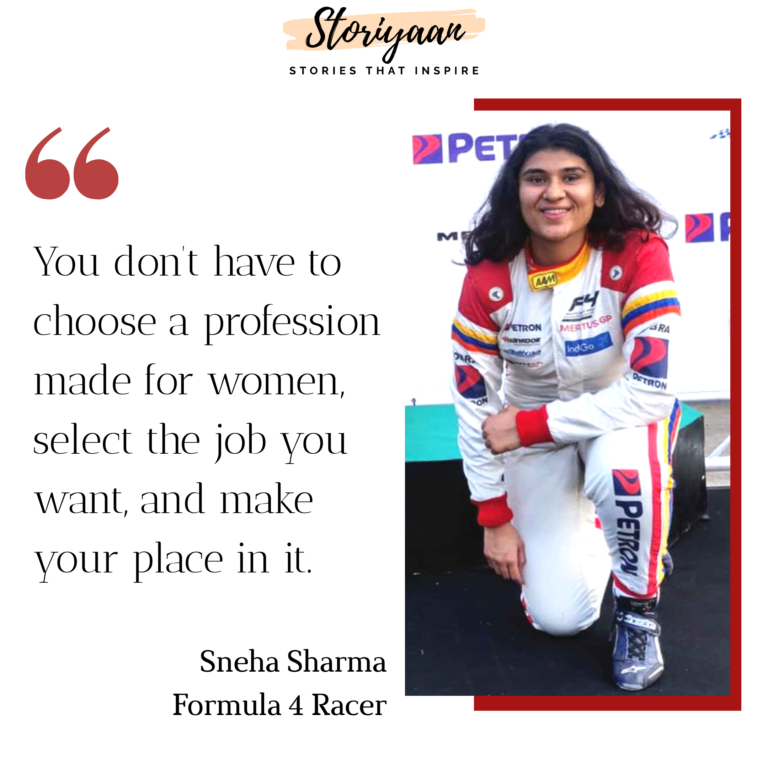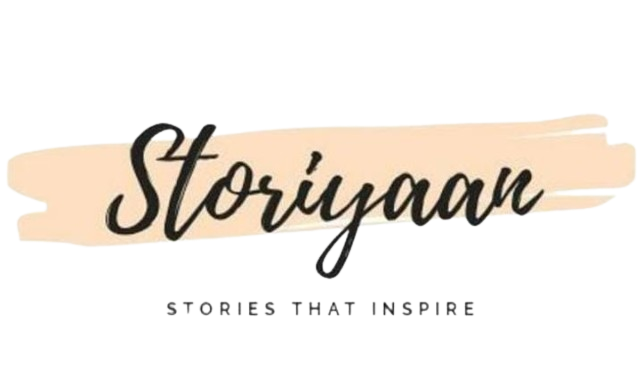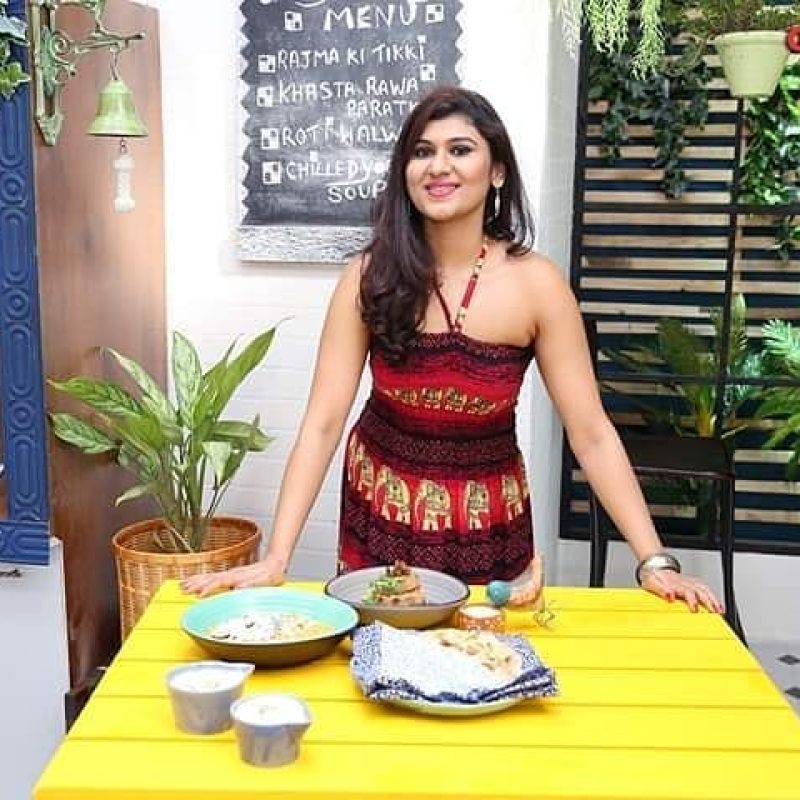Sneha Sharma is a racing driver. At the age of 17, she raced in the MRF National Karting Championship and later competed in the JK Tyre National Racing Championship. She was also the only girl to qualify for the final round of the KCT of the MAI National Karting Championship.
Sneha is given the title of India’s fastest female Racer after securing top 5 positions in the Mercedes Young Star Driver Program. She has also been shortlisted for the 2015 Volkswagen Vento Cup and The Toyota Etios Cup in India. She has won overall, six race victories and 14 runners up positions. Sneha also works as a Pilot for IndigoAirlines.
Storiyaan spoke with the great racer about breaking grounds with wheels, soaring the sky, and being the fastest female racer of India.

Interview
Questions and answers
You have been racing since the age of 16. How did you gain interest in car racing?
Oh, I had always loved speed when I was young. My cycle wasn’t a clichéd pink-ribbons-hanging-on-the-side, but a sports cycle with a curved handle and gears. I would ride it in the streets, and I would ride it reasonably fast. I wanted to explore my love for speed in depth. So I got hooked into go-karting. The adrenaline rush was like never before; it was my happy place. I didn’t have access to professional training, so I took training from the mechanics on the track. After which I partook in local races and caught the eyes of a national team at the age of 16. Racing was expensive, so I used to work on the tracks to pay for it.
When you told your parents about your dreams to be a car racer, how did they react? How difficult was it to be a car racer?
It was tough because they thought it was a dangerous sport and would hinder my studies. They were not pro of me doing that sport. So I would have to hide my helmet, I would jump the wall and race. It was tough, but I made sure I carried my books, to not fall in my academics. I studied between sessions and under the lamplight, during the night and day sessions and on the bus. So I had a sturdy grip on the wheel and in my academics too.
What kind of difficulties did you face during the initial days of your career as a racer? How did you deal with them?
It was tough because racing is a very physically draining sport. So I was quite an obese teen, I used to be 90 kgs, had to slack off 30 kgs to be a racing driver. Racing being lavish, it was tough getting enough money for practice. I would save my lunch money, pocket money and whatever money I got. That way, I was able to afford some practice sessions before my race. I did not have proper race gear, so I would just use school canvas shoes to drive. Earlier I couldn’t afford a rib-protector, so I was a frequent guest of injuries. Having competition with boys was just a cherry on top of my tough times.
You also trained to be a commercial pilot at Indigo. Why did you decide to put your racing career on hold to become a pilot? Were there any reasons?
I always wanted to fly. My father was in the Merchant Navy. I used to sail with him on a ship, and I liked to interact with the machines, the equipment, radars and the instruments on the ship. I was fascinated with aircraft. They looked like stars shooting in the skies. That made me want to fly. So I knew I had to get on my own feet and start earning because we were from a middle-class family. So I pressed pause and applied for a flying course.
You were the first trainee to fly a plane solo in your batch. How did you prepare for that? Were you nervous? How did you keep your calm?
I was very dedicated and followed the book religiously. Flying involves a lot of theory too, which I had aced in. I had even mastered flying simulations which added up to be an excellent rapport. It was a breathtaking experience, but I was nervous, which made me alert when I went on the flight, but as I buckled up, my excitement amped up.
What are the safety drills you have to undertake to incase of an emergency while flying a plane?
There are a lot of things. Now that I fly the Airbus 320, every six months we train again for hours. So that our skills never lose their edge. We prepare for failure phases to stand in an adverse situation. These are multi-dimensional stimulators with tripods and hydraulic legs. Some things are from memory, and other items are by checklist. So we know what to do when things go wrong, and you have to be very orderly once you take the decision.
You have often been the only female racer on the tracks. Did you ever face harsh comments from your male counterparts? How did you deal with it?
Initially, when I started, it was tough. At times people would come and tell me ‘I will take you off at the first corner’ or ‘We’ll crash into your car’ or ‘We’ll hit you.’ But, I always channel that aggression into my driving. Even if I broke down, I would do that locked up in a toilet. I would make sure I never let them see my tears. I would come back and get into driving and let that show them.
You said that car racing is an expensive sport and it is hard to find sponsors. How did you battle through that and achieve success?
When I was 19, I used to work on track. As a mechanic, trainer, tuner; all these things to be able to afford my driving. They would give me a subsidised driving cost. After that, I started performing well. Then I got sponsors. I even founded my racing with my salary and all of that for some time. Then I got JK tyre and Indigo, so they are my prime sponsors. Till the time you get sponsors, you drive substandard cars; you drive second-hand cars with second-hand engines. Things may not work their best. So you are at a disadvantage compared to the other drivers. So that’s how it works.
What kind of training does one have to undergo to be a race car driver?
You have to be very fit physically. You have to be able to have good cardiovascular strength and muscular strength. Then you need to have excellent hand-eye coordination. I went to a specialised gym last year in Chennai. There is only one unique gym in India which trains formula racing drivers. It excited me to prepare for racing. Then there is also braking techniques, cornering techniques, steering techniques, and how you overtake strategise your move. One needs to learn again how to drive in wet tracks and control the skid. Last year I went to near Vienna for training. I took a 3 – 4 days course. We did a lot of skid and drifts and all of that. So it was a fun experience to learn all of these things and enhance my training. It is dangerous; on the wet surface, the grip level is really low. Also, it is very tiring because it requires a lot of concentration to drive on a wet track. All my races in December were wet races 3 out of 4 races were wet races, so it was a tough decision. It was tough on the body and the mind, but it was a good track.
Which track would you rather race on, wet or dry?
I would like a dry track. You can push the car to its limits. I can do wet; I have done a good job at it, but I like dry driving better because you can drive fast.
How would you explain timing and reflexes as an integral aspect of racing?
Timing is the most crucial aspect of this profession. You have to drive fast within one-thousandth of a second. Along with that, you have to value time. Reflexes, Your body adapts biomechanically. So I move very fast, and I talk fast, my motor skills are quite accelerated. That is the result of racing. So it helps me in flying also. Flying helps in honing my fast reflexes for racing. Racing, in turn, helps me with quick decision making for flight. So they complement each other quite well.
Can you share some moments when your reflexes saved you in a race?
Once I was racing in Coimbatore. It was going well and good. Then this car behind me launched in the air and spun a few times and fell in front of me. It disintegrated mid-air, and it was terrifying. So at that time, I had to use rapid reflexes to avert the crash. To avoid it, to make sure that I don’t touch that other car. So that helped; reflexes.
Race Car driving is a dangerous sport. Does it ever scare you? You also had a severe knee injury a few years ago. How did you prepare to make your comeback?
I underwent a lot of physiotherapies. Although the injury happened in yoga sessions. I did a lot of physiotherapy and hydrotherapy in the swimming pool. I would tie bands on my legs and swim fast. I changed some 14-15 physiotherapists. So that gave me a lot of mental strength. When I had my come back, I became an international racing driver and became an airline captain. So I had to take a break as a first officer, but I came back as an international racing driver.
You have had various race victories under your belt. When you look back on your journey, what do you think was the most critical moment that changed everything?
What changed everything was the Malaysian race. The car had some limitations, some issues, it was scorching, and I was driving the first time on the track. But I drove very fast, and I finished first in the race and overall second. I was the only Indian in the race and the podium; nothing beats that.
What are the criterias to upgrade yourself to an F3 racer?
It’s a 4-day evaluation. There were fitness and psychological tests, and F1 drivers had come to take our assessment, so we did all of that. It was fun, so that’s why they selected me as the regional ambassador but not as wcd driver. So it was tough, but I had a good time going there, and it was a fully sponsored event. After that, I went back to the same place to take the training. So they say you should beat your enemy right, so the fact that I didn’t make it for the selection ground in Austria, we went back to take the training. I was there to take the training. So I overcame all my hurdles and then came back to racing.
What were your emotions when you received a signed model from renowned F1 racer Michael Schumacher?
Yeah, I have an autographed car by him. He didn’t personally give it to me, but it was a perfect emotion just as I had in the Mercedes program where we drove a car E60AMG with a speed of 270 km/hr as a national circuit. That’s an Indian F1 circuit. So that was when I received the car. It was an excellent feeling. I finished fifth, and I was the fastest woman there. It made me feel worthy. So I still have it in my living room. I look at it every day.
How do you think we can promote motorsports in women's participation in India?
I think by creating more awareness about it. I try to put on videos and pictures on my Instagram and other social media. I did the Tedx, and I also speak at colleges and corporate events.
So all of these things also help with creating awareness and there is a W I N wing for women in the motorsport wing of the national authority of motorsport. So these people also create awareness, they conduct drives and all. I used to go for women’s rallies. These rallies are a good entry point for women in motorsports. So I try to promote sports wherever I can. So yes, it is picking up. There are a lot of women now, women only championships which happen in JK Tyres racing championship.
As a girl, is there something you would like to share with other girls?
Yeah, pick a profession you like and make your place in it. You don’t have to choose a profession made for women, select the job you want, and make your place in it. Make your passion your paycheck; that’s what I tell them. You believe that when I am under a helmet, I’m not a guy or girl, I’m a racer. The 1st time I was selected in an all-male race; that’s the only time I felt like I was a girl. But after that, I felt like a racer. So any time you pick up a pen or anything, tell yourself that you are a trained professional, not a man or woman. People then start seeing women as professionals, and there will be no biases. Women will also have more confidence in them to do their job.
Quick 5
a. Favourite racer/ role model— Lewis Hamilton
b. Driving or flying— Trickier – flight is more tricky; driving is more difficult c
c. Most memorable race— The formula4 southeast Asia, 2019 championship
d. Languages you know—Hindi and English
e. Constant support throughout your journey— My mother and my sister .

